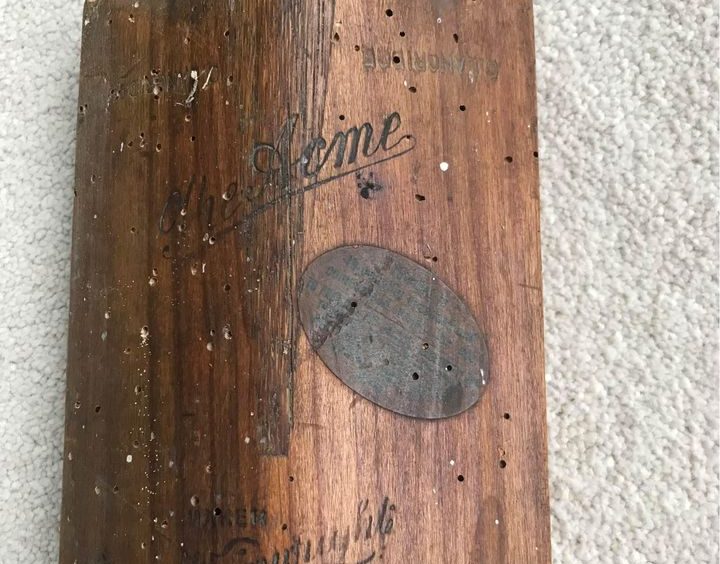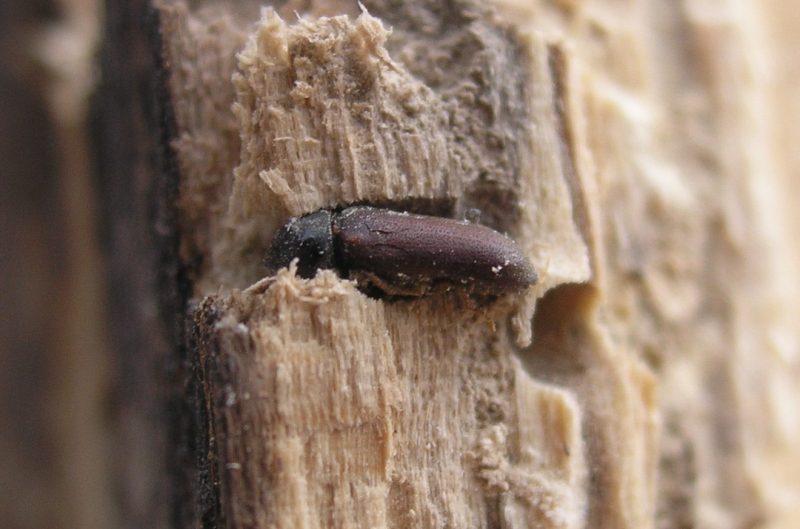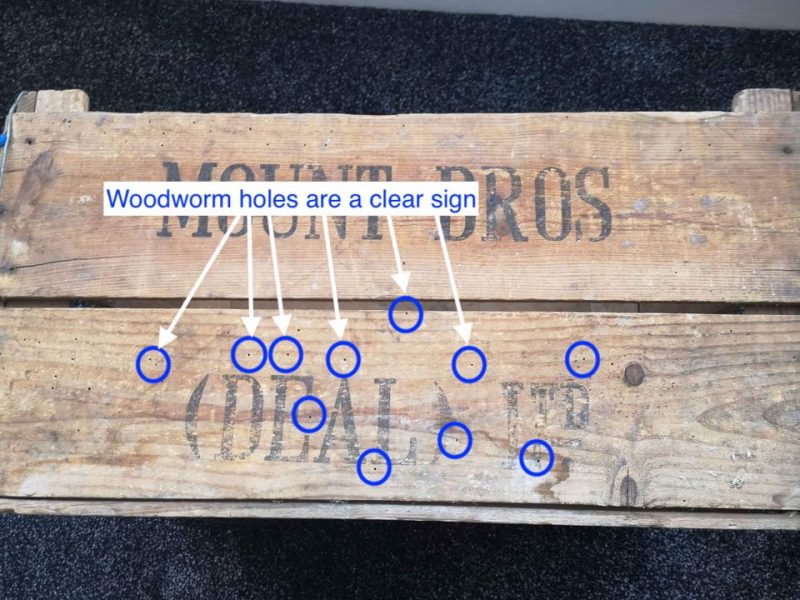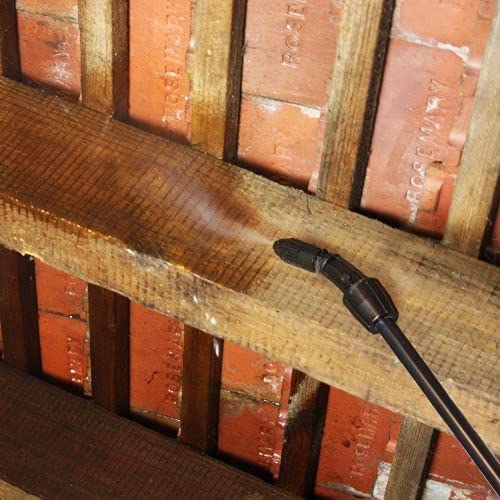Written by Terry Smith
Our site is reader supported so when you click a link to Amazon we may earn an affiliate commission.
UK’s best woodworm treatment for roof timbers, furniture, and sheds
This article was last updated on April 23rd, 2022 at 5:56 am
For those of us with a keen eye for older furniture or period properties with wooden beams and joists, we are used to people questioning our sanity when we explain that we spend endless hours in our shed, garage, or workshop, crafting furniture and tackling other projects in the home. The thing is, we don’t need them to understand why we do it, because we do. There’s just something incredibly satisfying about creating something with your own hands that is hard to explain to those that don’t feel the same way, and would rather pop to IKEA blissfully unaware of woodworm problems.

Those folks will also never understand the deep hatred we have for woodworm, and the damage it can cause to our beloved projects, and why we spend so much time trying to prevent it. To them woodworm conjures up some cute cartoon image of a smiling little creature, whereas to us, it’s an unseen monster that slowly devours our wooden wonders – worse still our roof trusses, or joists 😨 To keep your timber safe from this dreaded scourge, you really need to get your hands on the best woodworm treatments. Just a few sprays with one of these products and you can rest easier at night knowing your new table, bench, etc. is safely protected as it sits in your shed.
Below you will see our choices for the best woodworm treatments currently available for the UK’s DIY practitioners, and you just have to click on the one you are interested in to see our full review of that product.
Best woodworm treatment – editor picks:
Best overall woodworm treatment UK: Safe Guard Soluguard woodworm treatment
Best for roof timbers: Everbuild woodworm killer – thanks to a deep penetration
Best for sheds: Cuprinol woodworm killer – the odour isn’t too strong
Sensible alternative pick: Barretine woodworm control
Budget pick: Nourish and Protect woodworm killer
However, if you’re new to the war on woodworm, then we have some information coming up that you might just be interested in…
What is woodworm?
Woodworm is the umbrella term used for the larvae of various beetles, most commonly furniture beetles or boring beetles, that are born in, and feast on, wood. The term is also often spoken to refer to the infestation itself, and you might hear someone say ‘We’ve got woodworm’. This doesn’t mean that the poor so-and-so has an unfortunate parasite inside him or her personally, but rather an infestation in their house, or some kind of woodwork project.

The entire cycle of the beetle laying the eggs, the eggs hatching into grubs, then turning into pupa, and then beetle to start the cycle over again, can take years, and all that time your lovely wood is acting as the fuel for the process.
Signs you’ve got a woodworm problem
The first rule of woodworm club is, you don’t see woodworm. Actually, that’s not completely true, I’ve just always wanted to quote the movie fight club, but it is sort of truthful.
You see, the beetles that are the cause of woodworm infestations don’t lay their eggs on the surface of the wood, they lay them just under it, and so you have no idea that they are there. Even when the eggs hatch, you rarely see the grubs themselves, but they are in there alright, munching away on your prized woodwork, wooden flooring, ceiling beams, and just about anywhere else. You’ll start to see holes in your wood first:

Usually, the first signs that we see of a woodworm problem are lots of tiny holes, usually around 1mm-1.5mm in diameter but sometimes larger for some kinds of beetle larvae, spread across the piece of wood. There is sometimes the grub’s fecal matter, called frass, that resembles powder around the holes, and this lets you know that this is a current infestation and not the remnants of an old one.
Another sign of having a woodworm problem is finding the dead bodies of beetles on your window sills, or near other sources of light. This is because once the woodworm has grown into beetles, they often fly straight towards whatever light they see, but they don’t have a very long life span, and so you often see their corpses lying around.
Will my woodworm problem spread to other parts of the house?
Once woodworms have matured into fully grown beetles, they will often head towards a window or some other form of light as mentioned above. However, they will also annoyingly lay more eggs of their own, sometimes in the same piece of wood that they were born in, but sometimes in other pieces of wood nearby.
So, yes, it is possible that woodworm can spread to other parts of the house, and so you should definitely protect your timber from it.
How can I prevent woodworm in the first place?
There’s an ancient form of Morris dancing that is well known for preventing….
Sorry, couldn’t help myself. No, there’s no bell ringing, funny sock-wearing magic that will prevent woodworm, but understanding what leads to the problem in the first place could help you.
The overwhelming majority of woodworm cases in the UK are caused by the aptly named furniture beetle, who mostly enjoy infesting and feeding on hardwoods with a high moisture content of over 28%, but aren’t that picky and will enjoy softwoods given the chance.

Other types of beetles might have a preference for specific kinds of wood, but one thing is fairly universal- like stuff that is soft, and therefore easy to chew on. This is why woodworm infestations are most common in damp wood.
So, a good way to prevent woodworm settling in, other than using a chemical treatment, is to make sure that your home or working space has good ventilation, and maybe add a space heater or similar to ward off damp, if needed.
How effective are over-the -counter woodworm treatments?
We mentioned earlier that most woodworm problems are caused by the common furniture beetle, and any of the woodworm treatments we have reviewed below will do a cracking job of getting rid of them, or protesting against future infestations.
However, in some rare cases the problem is caused by deathwatch beetles which bury their eggs much deeper into the wood, and so, spray and brush on treatments won’t do much against them.
If you use a spray on treatment and it has no effect, it would be a good idea to get a specialist in to have a look and to tell you exactly what kind of woodworm problem you have. It will mean that it costs you more, but for some kinds of beetles, there aren’t any other options I’m afraid.
Having a specialist come take a look will set you back around 100-300 quid, which is already steep enough, but the expense can get much higher if you need to fumigate your home, which can run up to 500-1000 pounds in some cases.
Like we said though, this is in rare cases, and most woodworm problems are easily dealt with using spray on or brush on products like the ones featured in our reviews section below.
Best woodworm treatments reviewed UK
We’re just about to start our very popular reviews section of this article, where we will take a brief, but close look at the best woodworm treatments on the market at the current time. Don’t worry about these reviews being sugar coated, as we’ll point out flaws if we see them as well as highlight the good points, for a balanced and fair review.
1. SAFEGUARD Soluguard Woodworm Treatment - Ready For Use High Strength Woodworm Killer Spray (5 Litre, Clear)
Our pick for best overall woodworm treatment is Safe Guard’s Solugard product, a versatile treatment that can be applied via spraying or brushing, which can help when trying to get into awkward spaces.
Soluguard is a 0.2% permethrin solution, and this makes it very, very effective at not only killing beetles and their offspring, but also at acting as a preventative coating and stopping those mini vandals getting settled in there in the first place.
The down side to this, is that the chemical is highly toxic and you’ll need to be careful when handling it, and always use the correct safety equipment to keep it off your skin, or out of your lungs.
Although Safe Guard would like you to believe that there is no solvent smell, there is still an odour, as there is with every single woodworm treatment I’ve ever come across. It does fade within 24 hours and completely goes away after a few days though so it is tolerable, especially when you know it is killing off any beetles, larvae, and even any eggs that are found in that piece of wood.
The only thing I’d mark this product down for is the sprayer that comes with it. It’s not terrible, but I have my doubts about how long it will last. Saying that, you can buy a much better one for not much more than a couple of pints these days, so it’s not a big issue.
2. Everbuild Woodworm Killer, Clear, 5 Litre
Everbuild’s woodworm killer is an effective treatment for the price, doing a great job of eliminating woodworm from furniture, floorboards, and pretty much anywhere else they might have infested.
One of the biggest problems with treating woodworm with sprays and brush on chemicals, is that the eggs and larvae that are causing the damage are always buried beneath the surface.
This brand has attempted to tackle this problem with their ‘micro fine active technology’ that I won’t even pretend to understand on a scientific level. All I’ll say is that in our tests, it worked the way that they said it would, even on roof timbers, so no complaints from us.
Again, there is a strong smell that comes from using this product, and it did persist longer than the Soluguard product, but it isn’t a really bad odour and will eventually go away as long as you ventilate the area. My wife would probably say the same thing about yours truly, except I can’t kill woodworm.
You really need to make sure you wear protective clothing when using this stuff. NNot only is it toxic and shouldn’t be inhaled in large amounts, I dropped a little on my exposed wrist and it gave a slight burning sensation and had to be washed off immediately.
One of the benefits of this product is that it is designed to kill other types of wood boring pests and not just woodworm, so it provides good overall protection for your wood. On top of that, it can be painted over once dry, and you can even use varnish, stains, etc. too if you wish.
3. Cuprinol Woodworm Killer 500ml
One of least unpleasant when it comes to strong odours, Cuprinol’s woodworm killer might be just the thing for you if strong smells really put you off. If you don’t know Cuprinol, they are ultra reliable for wood preservatives. They’ve been making Cuprinol 5 Star for more years than I can remember – I’ve been using it for decades –
Let me be clear, there is still a smell but it didn’t seem as harsh to me as a lot of others, and my sister-in-law, who gets dizzy while using marker pens, said that it didn’t bother her too much which was certainly surprising.
I think one of the reasons for this softer odour is that the solution is quite watery, and this does have its drawbacks. The main one being that it can be a bit runny when you’re brushing vertical surfaces like poles, beams, table legs, etc.
Despite being a ‘bit of a drip’ it is actually quite strong in the sense that it does kill woodworm effectively. Most of the areas we treated were ‘cured’ after the first coat, but one or two areas needed a second one to finish the job.
Curpinol’s woodworm killer is a clear solution and won’t stain or discolour your wood, and once dried, you are free to paint over it. Having said that, we only tested with a couple of coats, so I can’t say for sure what will happen if you are giving your wood multiple treatments, but I would guess it’ll be fine.
4. Barrettine Woodworm Control Fluid Trigger Spray 500ml
Unlike Curpinol’s water-based woodworm killer that we just reviewed above, this woodworm control fluid from Barrettine is an oil-based solution, which means that it should be absorbed by the wood better.
Does this work out that way in the real world? Well, it’s hard to say really but we did notice that woodworm activity had stopped after we gave the test piece a couple of good coats of this stuff.
One thing I will point out, is that the spray bottle in which the treatment comes isn’t the best for accurately spraying into the small holes, so you might want to swap it for a better bottle if that’s your plan of action.
For an oil-based woodworm treatment, it is a little runny too which surprised me, but on the plus side there is very little odour to deal with, so it’s a good choice for working in small indoor spaces. You should still ventilate the area though, just to be clear.
Another good thing about Barrettine’s woodworm solution is that it dries quite quickly, around 3 hours in our tests, and once dry it shouldn’t be harmful to pets. It is also safe to varnish, paint, etc. over it once dried.
5. Nourish & Protect SPWW001 1 L Solvent Preserver Woodworm Killer, Clear
Without a doubt the best budget woodworm treatment is this stuff from Nourish & Protect, a product that gives you great value without scrimping on the effectiveness.
With a solution that is relatively high in permethrin (nearly 0,3%), this isn’t something that you want to be playing around with, and I strongly suggest you treat it with respect. That means covering up exposed skin, wearing a mask, goggles, and gloves.
Because of its high toxicity, it is a very effective and efficient killer of all kinds of beetles and their larvae, including longhorn beetles and boring weevils. It will also kill off any eggs that it has direct contact with, so make sure you get it into those holes and deep into the wood.
This is an oil-based woodworm treatment, and I didn’t find it to be as drippy or runny as some that we tested, and it went on well with just the use of a standard brush. I wasn’t waiting forever for it to dry either, and it could be painted over within a few hours.
Odour-wise, it is a bit of a strange one. The smell isn’t what I would call strong or overpowering, but it isn’t very pleasant, and you can tell that this stuff is toxic. For this reason, I would only recommend using it in well-ventilated areas and leaving the treated wood in those areas for a few days before moving it.
Well, there you have 5 excellent woodworm treatments to choose from. There are others out there, but we are confident that we have selected the best of them for you. If new products become available that impress us in the future, we will certainly add them to this shortlist, just as we do with all our review pages.
Remember, if you have a serious woodworm problem that just won’t go away, no matter how many times you spray on a treatment, you might have a dead watch beetle infestation, and will need the help of a specialist. However, as spray on treatments are the much cheaper option and often very effective, I would try them first.








